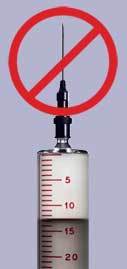[ Spring 2008 ]
New “dry-spray” technology passes muster in guinea pigs
Aiming to make immunization safer and more cost-effective for the developing world, Harvard School of Public Health Dean Barry R. Bloom and two bioengineers at Harvard, David Edwards and doctoral student Yun-Ling Wong, have developed a new method for delivering vaccines that does not require needles. Prepared by spray drying, a technology used to make powered milk and other food products, their innovation is a dry-powder preparation of the live, attenuated anti-tuberculosis vaccine, bacille Calmette-Guérin (BCG), that can be delivered by aerosol through the mouth or nose to the lungs.
BCG is the most widely used vaccine in the world, given annually to more than 100 million children. Its protective effects are highly variable, however, ranging from 0 to 80 percent in different parts of the world.
In the March issue of the Proceedings of the National Academy of Sciences (PNAS), the researchers found their new aerosol vaccine more effective in laboratory animals than a comparable dose of BCG given by injection.
The Bill & Melinda Gates Foundation funded the team’s work as part of the foundation’s Grand Challenges program to encourage safer, lower-cost alternatives to injectable immunizations. According to Bloom, the new dry-spray form would end children’s exposure to reused, unsterilized needles, which are common in developing countries. Half of all injections in developing countries are given with non-sterile needles and syringes, which cause 8 to 16 million infections per year of hepatitis B, 2 to 5 million cases of hepatitis C, and 80,000 to 160,000 cases of HIV, explains Bloom, a principal investigator on the project and a world renowned immunologist who has studied TB for nearly four decades.
What’s more, Bloom says, the novel dry-spray vaccine is more heat stable than standard lyophilized, or freeze-dried, vaccines. It is therefore potentially ideally suited for use in resource-poor and rural areas.
Rising rates of tuberculosis and drug-resistant forms of the disease in the developing world amply illustrate the need for a more effective TB vaccine. But the hope is that a dry-spray version might become a generalizable manufacturing technology. “If the results seen in animals can be confirmed in human studies, this technology could be used not only for TB vaccines, but also for other vaccines that could protect millions of people against other infectious diseases,” Bloom says.
Nano-size particles key
The dry-spray technology is the brainchild of Edwards, the Gordon McKay Professor of the Practice of Biomedical Engineering at the Harvard School of Engineering and Applied Sciences, whom Bloom calls a “genius in nanoparticles and their delivery potential.” Edwards and doctoral student Wong first described how to make the dried vaccine in PNAS in 2006. Their method involves feeding a liquid jet of BCG vaccine instantaneously through a hot gas, then cooling it rapidly. The end product remains stable at room temperature for at least four months.
“The mycobacteria in the dried vaccine are weakened, but alive,” Edwards says. “They revive all their ordinary properties as soon as they enter the body.”
In guinea pigs, a species highly sensitive to TB, the inhaled vaccine was markedly more effective than the standard injected vaccine, according to the 2008 PNAS report, co-authored by Edwards, Bloom, and colleagues at the University of North Carolina-Chapel Hill; the Aeras Global TB Vaccine Foundation; MEND South Africa; and Manta Product Development, Inc., a Cambridge, Massachusetts-based design and engineering group. In animals given the inhaled vaccine and then exposed to TB, less than 1 percent of lung and spleen tissue showed damaging effects of the disease. By contrast, in animals treated with the same dose of the standard injectable vaccine, pathology following TB exposure consumed about 5 percent of lung and 10 percent of spleen tissue.
Edwards speculates that the inhaled vaccine may be more protective because it goes straight to the lungs instead of the bloodstream. Particles form at micrometer and nanometer scales in spherical and elongated shapes, which appears to improve dispersal in the mouth, he adds. According to Bloom, these minute particles may be taken up more readily by TB-fighting immune cells.
Human trials next
If the laboratory work continues to go well, patient trials could begin as soon as this year in South Africa, where the TB burden is high. Testing would be conducted in collaboration with MEND, a nongovernmental organization created by Edwards to develop drug-delivery systems for low- and middle-income countries. More studies must be done to confirm the vaccine’s stability and effectiveness. Regulatory hurdles, too, must be cleared before it is deemed safe for human testing. “What is exciting,” says Bloom, “is the opportunity brought about by this interdisciplinary collaboration that would not have been possible by individuals working alone.”
“There is a pressing need for a better TB vaccine,” says Duke University vaccine expert Richard Frothingham. “We don’t yet know whether this new route will be safe in diverse human populations. However, environmental stability and needle-free delivery are advantages for a vaccine that’s to be used in the developing world.”
Charlie Schmidt writes about science, medicine, and public health for publications that includeEnvironmental Health Perspectives, the Washington Post, and Discover magazine.
Photo: Jonathan Kantor, Stone/Getty Images
